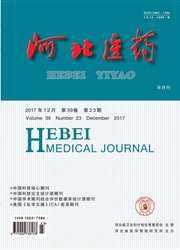

 中文摘要:
中文摘要:
目的观察丹参酮ⅡA磺酸钠联合阿托伐他汀对冠心病患者氧化应激及血管内皮功能的影响,探讨丹参酮ⅡA磺酸钠治疗冠心病的可能机制。方法选取2014年1月至2015年1月诊治的冠心病患者160例,随机分为对照组和观察组,每组80例,对照组在常规治疗基础上给予阿托伐他汀治疗,观察组在对照组基础上加用丹参酮ⅡA磺酸钠注射液,疗程为30d。观察2组治疗前后左心室射血分数(LVEF)、左心室收缩末期内径(LVESD)、左心室舒张末期内径(LVEDD)、内皮依赖性血管舒张功能(FMD)、非内皮依赖性血管舒张功能(NMD)、超氧化物歧化酶(SOD)、丙二醛(MDA)、一氧化氮(NO)、内皮素1(ET-1)、血栓素(TXB2)、6-酮-前列腺素F1a(6-Keto-PGF1a)、血管性血友病因子(vWF)、血管内皮生长因子(VEGF)变化。结果与治疗前比较,治疗后2组LVEF、FMD、NMD、SOD、NO、6-keto—PGF1a、VEGF显著升高,LVESD、LVEDD、MDA、ET-1、TXB2、vWF显著降低,差异有统计学意义(P〈0.05),但观察组上述指标改善程度优于对照组,差异有统计学意叉(P〈0.05)。结论丹参酮ⅡA磺酸钠联合阿托伐他汀能够有效改善患者心功能,其机制与抑制机体氧化应激及改善血管内皮功能有关。
 英文摘要:
英文摘要:
Objective To observe the effects of sodium tanshinone Ⅱ A sulfonate combined with atorvastatin on heart function, oxidative stress and vascular endothelial function of patients with coronary heart diseases (CHD) in order to explore the possible action mechanism of sodium tanshinone Ⅱ A sulfonate in the treatment of CHD. Methods One hundred and sixty patients with CHD who were diagnosed and treated in our hospital from January 2014 to January 2015 were randomly divided into control group and observation group, with 80 patients in each group. The patients in control group, on the basis of routine therapy, were given atorvastatin, however, the patients in observation group, on the basis of control group, were given sodium tanshinone II A sulfonate,with a treatment course of 30 days for both groups. The Changes of LVEF, LVESD, LVEDD, FMD, NMD,SOD, MDA,NO, ET-1, TXB2,6-Keto-PGF1 a, vWF and VEGF levels were observed before and after treatment in both groups. Results As compared with those before treatment, the levels of LVEF, FMD, NMD, SOD, NO,6-keto-PGFla and VEGF were significantly increased after treatment, however, the levels of LVESD, LVEDD, MDA, ET-1, TXB2 and vWF were significantly decreased in both groups ( P 〈 0.05 ). Moreover the improvement degree in observation group was more obvious than that of control group ( P 〈 0.05 ). Conclusion Sodium tanshinone Ⅱ A sulfonate combined with atorvastatin can significantly improve cardiac function of patients with CHD, and its action mechanism may be correlated to restraining oxidative stress and improving vascular endothelial function of patients with CHD.
 同期刊论文项目
同期刊论文项目
 同项目期刊论文
同项目期刊论文
 期刊信息
期刊信息
